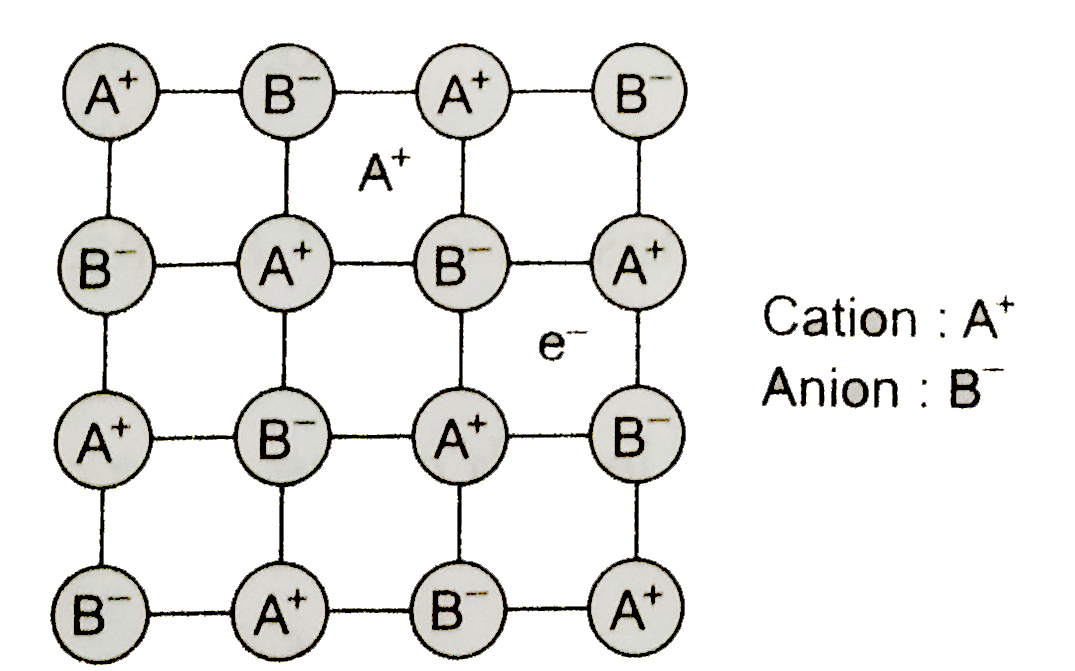Write two points of distinction between Schottky and Frenkel defects.
To distinguish between Schottky and Frenkel defects, we can consider the following two points:
1. Definition of the Defects:
- Schottky Defect: In a Schottky defect, an equal number of cations and anions are missing from the crystal lattice. This results in vacancies where both types of ions are absent.
- Frenkel Defect: In a Frenkel defect, a smaller cation is displaced from its original lattice position and occupies an interstitial site within the crystal structure. This means that while one ion is missing from its original site, it is not lost from the lattice entirely.
2. Effect on Density:
- Schottky Defect: The removal of equal numbers of cations and anions leads to a decrease in the total number of ions per unit cell. Consequently, the molar mass decreases, leading to a decrease in the density of the solid.
- Frenkel Defect: Since only one ion is displaced and occupies an interstitial site, the total number of ions per unit cell remains the same. Therefore, the molar mass and density of the solid remain unchanged.
Summary of Distinctions:
- Point 1: In Schottky defects, equal numbers of cations and anions are missing, while in Frenkel defects, only cations are displaced to interstitial sites.
- Point 2: Schottky defects result in decreased density due to the loss of ions, whereas Frenkel defects maintain the density since the total number of ions remains constant.
- Schottky Defect: In a Schottky defect, an equal number of cations and anions are missing from the crystal lattice. This results in vacancies where both types of ions are absent.
- Frenkel Defect: In a Frenkel defect, a smaller cation is displaced from its original lattice position and occupies an interstitial site within the crystal structure. This means that while one ion is missing from its original site, it is not lost from the lattice entirely.
- Schottky Defect: The removal of equal numbers of cations and anions leads to a decrease in the total number of ions per unit cell. Consequently, the molar mass decreases, leading to a decrease in the density of the solid.
- Frenkel Defect: Since only one ion is displaced and occupies an interstitial site, the total number of ions per unit cell remains the same. Therefore, the molar mass and density of the solid remain unchanged.
- Point 1: In Schottky defects, equal numbers of cations and anions are missing, while in Frenkel defects, only cations are displaced to interstitial sites.
- Point 2: Schottky defects result in decreased density due to the loss of ions, whereas Frenkel defects maintain the density since the total number of ions remains constant.
Similar Questions
Due to Frenkel defect, the density of ionic solids:
View SolutionWrite two points of distinction between crystalline and amorphous solids.
View SolutionWhich has Frenkel defect ?
View SolutionState the difference between Schottky and Frenkel defects. Which of these two changes the density of the solid ?
View SolutionWhat are the consequences of Schottky and Frenkel defects?
View SolutionGive the name of one solid which shows both Schottky and Frenkel defects?
View SolutionSchottky defect is-
View SolutionIonic lattic has two major points defects ,(1) Schottky (2) Frenkel defects . Schottkly defects occurs due to the cations - anion pair's missing from the lattice sites . Frenkel defects occurs when cation leaves its lattice site and fits into an interstitial space. The neutrality of the crystal is being maintained and we considered all losses from interstitial positions.
which defect decrease density of the crystal ?
View SolutionIonic lattic has two major points defects ,(1) Schottky (2) Frenkel defects . Schottkly defects occurs due to the cations - anion pair's missing from the lattice sites . Frenkel defects occurs levels its lattic site and fits into an intersitial space. The neturaity of the crystal is benig maintained and we considerd all losses from interstitical positions.
Structure shown here represents :

View SolutionIonic lattic has two major points defects ,(1) Schottky (2) Frenkel defects . Schottkly defects occurs due to the cations - anion pair's missing from the lattice sites . Frenkel defects occurs levels its lattic site and fits into an intersitial space. The neturaity of the crystal is benig maintained and we considerd all losses from interstitical positions.
Structure shown here represents :

View Solution
